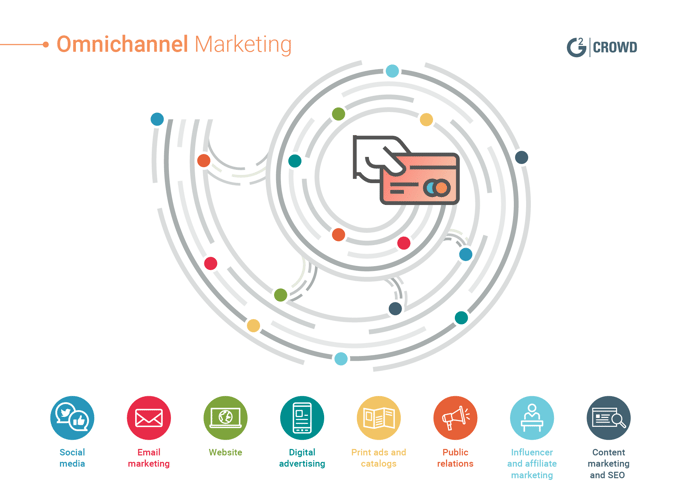Where were you when the apocalypse started?
Oh, you don’t remember? It began about eight years ago; maybe you’ve noticed the abandoned malls, the closing storefronts, the dying brands. Maybe your business has felt it, maybe you’re taking steps to mitigate the damage.
The retail apocalypse is happening, and we may not have seen the worst of it yet.
Wait, What?
The Retail Apocalypse
All dramatics aside, the retail industry is experiencing a huge shift. Due to retail technology, storefronts are closing, it’s true, and online retail is undeniably growing, but e-commerce only makes up 11.9 percent of all retail sales.
So why are so many malls being abandoned, and why are long-standing companies like Toys R Us and J.C. Penney and Sears going bankrupt?
TIP: Learn more about the downfall of Sears.
Why are storefronts closing?
The answer, as you might assume, is complex. But I want to preface the answer with the fact that the storefront is not dying. And despite the catchy moniker, “retail apocalypse” is not entirely accurate. The retail apocalypse does not mean the complete destruction of the brick-and-mortar store as we know it. Retail, however, is changing.
You’re probably aware of the e-commerce boom. (It’s likely you’re a frequent user, since Amazon essentially owns e-commerce in the U.S.) A projected 49 percent of e-commerce purchases in the US will be made on Amazon to the estimated tune of $258 billion by the end of 2018. That’s five percent of the total retail spend, online and offline. It’s a digital mall that now carries everything and anything you could imagine and has a physical footprint as small as a mobile phone.
And, yes, stores are closing. According to Business Insider, 3,800 stores will close in 2018. Toys R Us is closing 735 stores, Walgreens and Rite Aid are closing 600, Best Buy is closing 250, and Gap is closing 200 stores through 2020. That sounds like a lot, and it is, but one must also consider that the U.S. has an insane amount of real estate dedicated to retail.
In the U.S., there are 23.5 square feet of retail space per person. Compare that to Canada, which has 16.8 square feet of retail space per person. That may not seem like a huge difference, but remember that the U.S. has about ten times the population of Canada (around 330 million to around 35 million, respectively). That’s an insane amount of space. In fact, it’s too much space. The U.S. population isn’t growing as fast as it once was, so all that retail space is no longer needed to keep up with demand. And with e-commerce coming more to the forefront of retail, the closing of a few thousand stores is not the apocalyptic event it’s been made out to be.
One must also consider that the face of retail has changed. Department stores are no longer the go-to for goods and sundries. Big box stores replaced the need for department stores, which, in turn, replaced the need for malls. The shift of buying power from baby boomers to millennials is yet another factor. Millennials not only have less buying power than baby boomers did at their peak, but also have more interest in spending money on experiences over objects. That means more money injected into leisure and restaurants over retail.
If trends continue, it’s possible more closures are on the horizon. The e-commerce juggernaut is not slowing, and brick-and-mortar must adapt. And while this isn’t an entirely adapt-or-die situation, customers will be looking for tech-enabled retailers to provide a more omnichannel experience.
Long live omnichannel retail
Omnichannel marketing is quickly gaining traction, and for good reason. By bringing together and combining various marketing channels, customers are given options when interacting with a brand. The same principles apply to omnichannel retail.

The retail model that revolves solely around the brick-and-mortar storefront is dead, if not dying. Customers want the option to go to the store, order online, or do something in between. More and more stores are offering options like ordering online and picking up in store. Or ordering online and returning unwanted items in a store. Or even buying something in store and returning online through the mail. These are all facets of omnichannel retail.
Creating a truly omnichannel experience is neither easy nor simple. It requires a lot of software solutions working in tandem with your various workforces. But with the holidays quickly approaching and the fact that small and mid-size retailers make anywhere between 20 and 40 percent of their yearly sales during the holiday season, now is the time to start thinking about digital transformation and implementing omnichannel strategies for next year.
Some blame retailers’ reticence to modernize their stores and systems as the cause of the retail apocalypse, but that’s not entirely true. It’s one of many causes, certainly, and one that can be addressed relatively quickly.
But all hope is not lost.
Retail's silver lining
Retail is not dying. If anything, retail is growing. Retail sales were at a record $5.7 trillion in 2017, and there are no signs of that growth slowing in 2018. In fact, many brands are opening more stores in 2018. Some argue the apocalypse isn’t even happening.
Reportedly, though 3,800 stores are closing this year, 1,700 are opening. Ulta is slated to open 100 stores, Ross is planning to open 100 stores, Dollar General is opening 900 stores (!!!), and even though Gap is slated to close 200 stores by 2020, its sister brands, Athleta and Old Navy, are opening 200 stores this year. Bass Pro Shops increased its sales by 94 percent last year, compared to Amazon’s 45 percent.
I, for one, am extremely interested to see how the retail industry fares this holiday season. Black Friday is post-apocalyptic on its own with people scrambling for waffle irons and TVs, but this year it will be doubly so. But, if the current trend holds, retailers will do more business during the holidays than they did last year.
Retail is changing, but that’s only because we’re changing. And that’s a good thing. The retail apocalypse sounds frightening, but it’s necessary. After the so-called apocalypse, retail will become more suited for our connected world. It’s not the retail apocalypse. It’s the retail metamorphosis. I’m excited to see that butterfly.
For more research into how technology is impacting industries, check out this article on restaurant technology.
 by Melike Ulaman
by Melike Ulaman
 by Sagar Joshi
by Sagar Joshi
 by Andrej Kovačević
by Andrej Kovačević